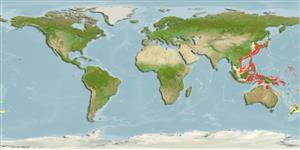Malacostraca |
Decapoda |
Chirostylidae
Environment: milieu / climate zone / depth range / distribution range
Ecology
Benthic; depth range 68 - 439 m (Ref. 76893). Deep-water
Western Pacific: Japan, Taiwan, Indonesia and the Philippines.
Length at first maturity / Size / Weight / Age
Maturity: Lm ? range ? - ? cm
Life cycle and mating behavior
Maturity | Reproduction | Spawning | Eggs | Fecundity | Larvae
Members of the order Decapoda are mostly gonochoric. Mating behavior: Precopulatory courtship ritual is common (through olfactory and tactile cues); usually indirect sperm transfer.
Baba, K., E. Macpherson, G.C. Poore, S.T. Ahyong, A. Bermudez, P. Cabezas, C.-W. Lin, M. Nizinski, C. Rodrigues and K. Schnabel 2008 Catalogue of squat lobsters of the world (Crustacea: Decapoda: Anomura - families Chirostylidae, Galatheidae and Kiwaidae). Zootaxa 1905:1-220. (Ref. 76884)
IUCN Red List Status
(Ref. 130435: Version 2025-1)
CITES status (Ref. 108899)
Not Evaluated
Not Evaluated
Threat to humans
Harmless
Human uses
| FishSource |
Tools
More information
Trophic EcologyFood items (preys)
Diet composition
Food consumption
Predators
Population dynamicsGrowth
Max. ages / sizes
Length-weight rel.
Length-length rel.
Length-frequencies
Mass conversion
Abundance
Life cycleReproductionMaturityFecunditySpawningEggsEgg developmentLarvae PhysiologyOxygen consumption
Human RelatedStamps, coins, misc.
Internet sources
Estimates based on models
Preferred temperature
(Ref.
115969): 9.7 - 21.8, mean 17 (based on 156 cells).
